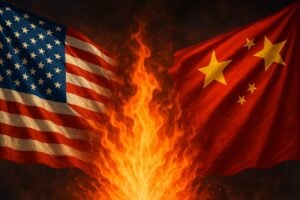The trade conflict between the United States and China intensifies further, as Beijing announces a robust economic counteroffensive in response to the new tariffs imposed by the Trump administration. On Friday evening, the Chinese government made public a series of policies that confirm its intention not to back down in the open confrontation with Washington. The heart of the response is a 34% increase on tariffs applied to imports from the United States, equivalent to those desired by the American president on Chinese goods.
United States vs China: symmetric tariffs for an increasingly heated commercial battle
The decision of China to apply 34% tariffs on American products represents a clear declaration of intent: no step back in the face of American pressure. The clash is now on a global scale, considering that the tariffs imposed by Trump affect imports from all over the world, not just from China. In response, Beijing has chosen the path of reciprocity, introducing identical tariffs both in percentage and scope.
The United States, through the new trade policies implemented by Trump, aimed to severely impact the Chinese trade surplus, but China has shown it has tools to respond. Although the Chinese tariffs will affect a smaller number of goods, it is only because China purchases much less from the USA compared to what it exports to them: in just the last year, the United States purchased Chinese goods worth 426.9 billion dollars, while China imported American goods valued at 147.8 billion.
China blocks 11 American companies: the strategic move
To make the Chinese reaction even tougher was the decision of the Ministry of Commerce to include 11 American companies in the “unreliable entities list”, preventing them from operating in the Chinese market or making agreements with local companies. It is a gesture that directly affects the American industrial and commercial system, which for years has benefited from access to the gigantic Chinese market.
The details about the companies involved have not been made public, but the measure follows the goal of further restricting cooperation in crucial sectors. In parallel, China is introducing a licensing system to control the export of seven rare earths, strategic materials for cutting-edge technologies such as electric cars and intelligent weapon systems. Since these rare earths are almost exclusively extracted and processed in China, the control over export represents a powerful weapon in the hands of Beijing.
Investigations on medical devices and halt to agri-food
In addition to tariffs and trade blocks, the Chinese Ministry of Commerce announced the initiation of two trade investigations on American medical products, particularly on imaging equipment, a sector in which the United States still holds a prominent position globally. The investigations, formally linked to alleged trade imbalances, are also a form of pressure on the few areas where the US industry maintains a competitive edge.
Another decisive blow came from the Chinese customs authorities, who blocked chicken imports from five of the largest U.S. agricultural exporters and sorghum from a sixth company. This move directly impacts the American agri-food sector, already severely tested in the past by trade tensions. The agricultural sector, historically one of the most tied to exports to China, now risks losing significant market shares.
The Asian giant flexes its muscles
The Chinese strategy is clear: respond firmly and target critical points of the American economy. Beijing does not seem willing to yield under Trump’s pressure, and the measures adopted so far are proof of this. With the strategic use of tariffs, trade restrictions, and control over critical resources, China shows itself prepared to sustain a conflict that goes well beyond the simple dispute over imports.
Although the Asian country cannot technically “match” the American tariffs, due to the large imbalance between what it exports and what it imports from the United States, the countermeasures implemented affect strategic sectors and aim to amplify the political and social impact of the sanctions.
The repercussions on global trade
The growing tension between the two largest economies in the world risks having destabilizing effects on the entire global trade system. The uncertainty generated by these exchanges of “economic blows” pushes international companies to review industrial plans, supply chains, and investments. The restrictions on the export of fundamental materials such as rare earths, for example, have implications that go beyond the simple bilateral clash: these are vital resources for the global technology industry.
In the meantime, the guerra dei dazi also becomes a geopolitical challenge in which two different visions of international trade and power relations are confronted. On one side, Trump’s unilateralism, on the other, the prompt Chinese response aiming to demonstrate the self-sufficiency and solidity of its economy.
Towards an escalation with no return?
With the new measures adopted by Beijing, the global commercial landscape appears even more uncertain. The balance is fragile, and every new action from one of the parties could generate chain reactions that are difficult to control. The question that many analysts are asking is whether there is still an opening for diplomacy, or if the two superpowers have now embarked on a road of no return.
In the meantime, global observers remain in anticipation of further developments, while the impact on local and international economies begins to be felt. At stake are not only billions of dollars in trade exchanges, but also the hegemonic position in the new world economic order. And neither of the two powers seems willing to take the first step back.


